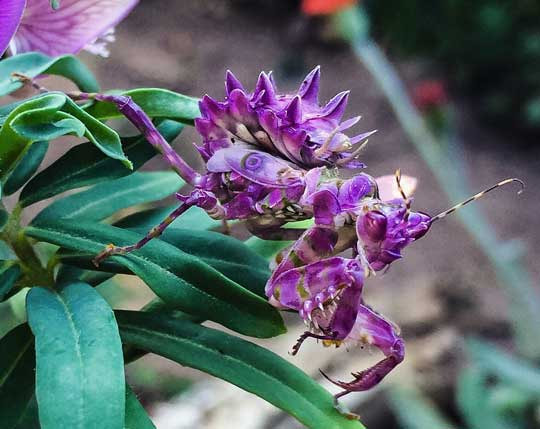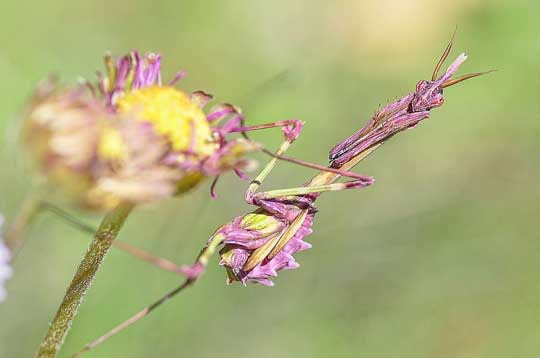|
The other day, Trish shared a post with me that featured several photos of a flower mantis. The creature was so beautiful that at first I wondered if it was even real. Well, flower mantises are indeed real. Somehow I had never known about them before! So, I decided to feature the flower mantis today, in case some of you have never heard of them. Yes, they are real. By the way, the person who found the above female flower mantis (in the Nkutu Valley, South Africa) named it Miss Frilly Pants. What the heck is a Flower Mantis? The flower mantises include about 1,800 species (wow!), most of them in the family Hymenopodidae. They are found in East Africa, as well as in South and East Asia. Like all mantises, flower mantises are extremely skilled and deadly predators. This, in fact, is why they look like flowers. They use a strategy called aggressive mimicry, which can most easily be described as a wolf in sheep's clothing. More on that below. I wish I could provide photos of all 1,800 species, but I'll have to settle on just a few. Amazing facts about Flower Mantises Flower mantises are tricky predators. As I mentioned above, they use aggressive mimicry. This is not the same thing as camouflage (which is blending into the surroundings so as to not be detected). Aggressive mimicry is when a predator is disguised as something that is harmless to its prey. In fact, it is usually something that attracts its prey. So, instead of blending into the surroundings (camouflage), the predator stands out so that it is very visible. It just isn't what it appears to be. Another example of aggressive mimicry is the alligator snapping turtle. The turtle sits on the bottom of a stream or pond, opens its mouth, and wriggles its pink tongue. To a fish, the tongue resembles a wriggling worm. The fish swims right into the turtle's mouth, and.... snap! Hence the name, snapping turtle. Predators that use aggressive mimicry don't have to go hunting for their prey. They simply sit and wait for the prey to come to them. By looking like flowers, flower mantises attract pollinating insects that like to feed on the flower nectar. The insects see the "flower," they fly right up to it, and... snap! Check out the orchid mantis below, beside an actual orchid that it mimics. Scientists have been fascinated by flower mantises for well over 100 years. One of the first people to describe them (although incorrectly) was the travel writer James Hingston in 1879. Hingston mistakingly thought that the flower mantis he was watching was actually an insect-eating plant: "I am taken by my kind host around his garden, and shown, among other things, a flower, a red orchid, that catches and feeds upon live flies. It seized upon a butterfly while I was present, and enclosed it in its pretty but deadly leaves, as a spider would have enveloped it in network." So, the mantis's mimicry worked so well that it even fooled this human observer. I feel compelled to further explore this type of mimicry. Actually, for a long time scientists mistakingly believed that flower mantises were an example of cryptic mimicry. In other words, scientists assumed the mantises looked similar to flowers so that they could hide among the flowers and wait for insects that were attracted to the flowers. There are plenty of examples of such cryptic mimicry, such as the crab spider in the photo below, which has just caught an unsuspecting wasp. Keep in mind that the wasp was attracted to the flower itself, not to the spider. For many years, this is what scientists believed flower mantises were doing. Eventually, however, they began to realize this isn't true of the flower mantis. Flower mantises do not hide within the flowers. In fact, they don't hide at all. They usually sit upon a background of green leaves so that they stand out. They are not trying to hide. They want to be seen. And this gets even stranger. It turns out that flower mantises are even better at attracting insects than the flowers themselves. If you put a flower mantis side-by-side with a similar flower, insects will visit the mantis more often than the flower. What? How can that be possible? We have to get into a bit of bug psychology to understand it. When we humans look at a flower mantis, it might fool us at first, but as we look closer, we see that something isn't quite right, and soon we figure out that it is an insect instead of a flower. That's how our brains work. Bees and flies, on the other hand, do not have this capability. They simply see the mantis's color, and they think, "Ooh, a flower... yummy!" Then they dart right in for some nectar, and... snap! So, insects are simply attracted to the specific color and the general shape of a flower, not really the details. The thing is, flower mantises usually do not look like any one specific type of flower. Instead, they have the characteristics of several kinds of flowers. In other words, they are structured to look like a generalized flower. And they attract more insects because some insects are specific in which type of flower they like... so, it is helpful to the mantis to look like several types! Flower mantises are actually the first animals we've ever discovered that capture their prey by mimicking a complete flower. Unlike other mantises that grab prey insects that are crawling on the ground or on a plant, flower mantises grab their prey out of the air. This happens in a fraction of a second, and the mantises are really deadly in their aim. Check out this cool video about flower mantises. Since these insects are so amazing to look at, I'll wrap this up by showing a few more examples: So, the Flower Mantis deserves a place in the R.A.H.O.F. (Ripsnorter Animal Hall of Fame). FUN FACT: The first documented use of the word ripsnorter was in 1840. It is considered an Americanism, and it refers to something or someone extraordinary ("That fiddler played a ripsnorter of a song"). It can also refer to something intense or violent ("That was a ripsnorter of a storm"). Flower mantises are definitely extraordinary, and they are also extremely powerful predators. So, it fits. Ripsnorter is another way to say awesome! Photo Credits:
Flower Mantis #1 - Waterfall Retreat & Environmental Centre Facebook Page Orchid mantis and orchid - Igor Siwanowicz via The Conversation Crab spider - Olaf Leillinger/Wikimedia via The Conversation Purple spiny flower mantis - iNaturalist via Twitter Very thin flower mantis - PXFuel - Creative Commons Flower mantis on tip with buds - Roger Meerts/Shutterstock via Discover Magazine Flower mantis on rolled-up leaf - Thinkstock via Mentalfloss
0 Comments
Leave a Reply. |
Stan's Cogitations
Everyone needs a creative outlet. That's why I write. Archives
July 2024
|








 RSS Feed
RSS Feed